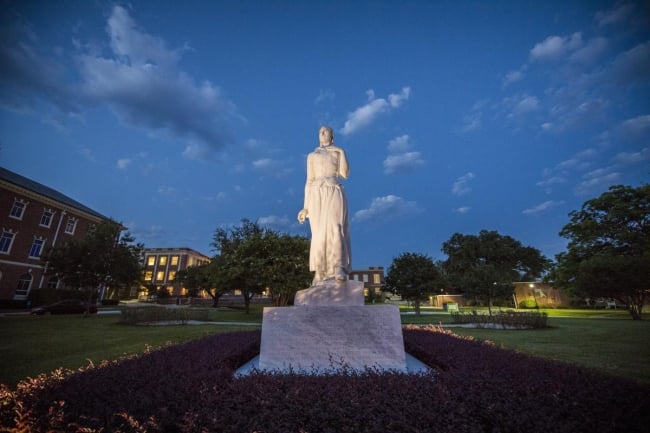You have /5 articles left.
Sign up for a free account or log in.

Texas Woman's University in Denton
Courtesy of Texas Woman's University
As many college and university systems look to downsize and consolidate, Texas Woman’s University has plans to grow. The coed, public university based in Denton, Tex., is now officially a university system.
A new Texas law established the Texas Woman’s University system as the seventh public university system in the state. The university’s three campuses in Denton, Dallas and Houston will become independent institutions under the new system. The Denton campus, which is the oldest and largest, will become the system’s flagship university.
The new system bucks a trend, said Jason Lane, dean of the School of Education at the State University of New York at Albany. He noted that many state university systems -- including those in Alaska, Georgia and Pennsylvania -- have completed or are considering consolidations.
“We’re at a moment where you’re seeing a movement toward greater consolidation and coordination,” he said.
Lane, who is also director of SUNY Albany’s Systems Center, an applied research center focused on collaborative approaches to improving student success, described Texas Woman’s plan as an example of “rare differentiation and autonomy.”
The system has many operational and managerial details to work out, said Carine Feyten, chancellor of the system and president of Texas Woman’s University in Denton. Two additional presidents will be hired to take the helm at the Dallas and Houston universities, and Feyten’s office will oversee the process, a university spokesperson said. Both institutions will also have to be independently accredited by the Southern Association of Colleges and Schools Commission on Colleges, which is the accreditor of Texas Woman’s University
These processes could take four or five years, Feyten said. Little will change at all three campuses in the short term. Administrative offices including admissions, financial aid and student life already exist on each campus and will remain operational. She said the new law did not authorize any additional state funding for the new system, and the funding structures will not change right away.
The new law is the first step toward creating three independent institutions under the system and bringing much-needed additional leadership to the Dallas and Houston campuses.
Feyten was stretched thin leading all three campuses. The Denton and Dallas campuses are within 45 minutes of each other, but the Houston campus is more than four hours away from them.
“I always felt that as a university, we haven’t totally served the communities in Houston and Dallas as well as we could,” Feyten said. “By having more dedicated leadership on the different campuses -- and those campuses becoming independent universities -- those campuses will be able to serve those local communities much better.”
When the mayor of Houston -- whose daughter attended the university -- visited the Houston campus, Feyten wasn’t there to greet him.
“There was no leadership present on the campus to really welcome an elected official,” she said. “It’s really unexcusable.”
Once presidents are appointed to the Dallas and Houston campuses, Feyten will serve only as chancellor of the system and president of the Denton campus.
The Texas Woman’s University system’s leadership model will mirror the University of Houston system, where the chancellor also serves as president of the flagship University of Houston. The system’s Clear Lake, Downtown and Victoria campuses each have their own presidents.
With Feyten serving as both Denton president and chancellor of the system, the system won’t need its own office and administration, she said.
"That also allows us to keep the cost lower," Feyten said.
Other university systems have been criticized for setting up similar leadership models. When the University of Missouri Board of Curators combined the system president role with the chancellorship at the main campus in Columbia, faculty members feared the move would create a flagship-satellite model that would unfairly benefit the Columbia campus.
Feyten isn’t concerned about getting similar pushback. All three universities in the Texas Woman’s system have shared one chancellor, and the additional leaders will be welcome, she said.
“It’s definitely something to be mindful of,” she said. “I have seen the opposite example, where you have system offices that are really built out and you have a school administration which is very expensive.”
There won’t be any job losses associated with the new system, said Matt Flores, a spokesperson for Texas Woman’s University. The university system will likely hire additional support staff for the two new presidents.
The law to create the system had bipartisan support in the Texas Legislature.
“Texas Woman’s University has exemplified the best of Texas higher education for many years,” Republican state representative Lynn Stucky, the bill’s House sponsor, said in a statement. “Even while experiencing record enrollment growth, TWU is the third-most affordable institution in Texas for total cost. I am proud to have authored this important legislation that will enable TWU to build on its success in producing high-quality graduates at a low cost for Texas taxpayers and students.”
Faculty members have yet to weigh in on the pending changes. They have not met since news of the new system was announced and will likely discuss it at a meeting in the late summer or fall, said DiAnna Hynds, a biology professor at Texas Woman’s and speaker of the Faculty Senate.
Despite what its name may suggest, Texas Woman’s is a coed university and has been since 1994. The public system enrolls about 16,000 students -- the largest student head count of any woman-focused university in the country, Feyten said. Women still make up about 87 percent of the student body, according to the National Center for Education Statistics.
Today, the university is focused on enrolling underserved student populations, Feyten said.
“This university has, since its inception, really always been focused on serving populations that don’t typically go to college,” she said. “About half of our students come from lower socioeconomic backgrounds -- Pell eligible, first generation.”
About a third of Texas Woman’s students are Hispanic or Latino, 17 percent are Black or African American, 9 percent are Asian and 37 percent are white, according to NCES. An overwhelming majority of students -- 98 percent -- are from Texas. More than half of first-time, full-time undergraduate students receive Pell Grants.
A university system can usually provide more flexibility for students and reduce competition among the three existing campuses, said Rebecca Martin, executive director of the National Association of System Heads.
“A system really can overcome some of the competition among campuses by putting the student first and improving pathways among campuses,” Martin said.
Several elected officials asked Feyten if the university would like to integrate into an existing Texas university system. Feyten was worried that merging with another system would cause Texas Woman’s University to lose its distinctive identity. It would also force the university to abandon its requirements that at least four women serve on the Board of Regents at all times.
Lane, the dean of the School of Education at SUNY Albany, said the success of the new system will lie in the results of decisions about which administrative tasks will be shared and which will be duplicated on each campus.
“Ultimately it will come down to where authority and autonomy rests, and what do they want to decentralize and what do they want to keep central and coordinated,” he said.




